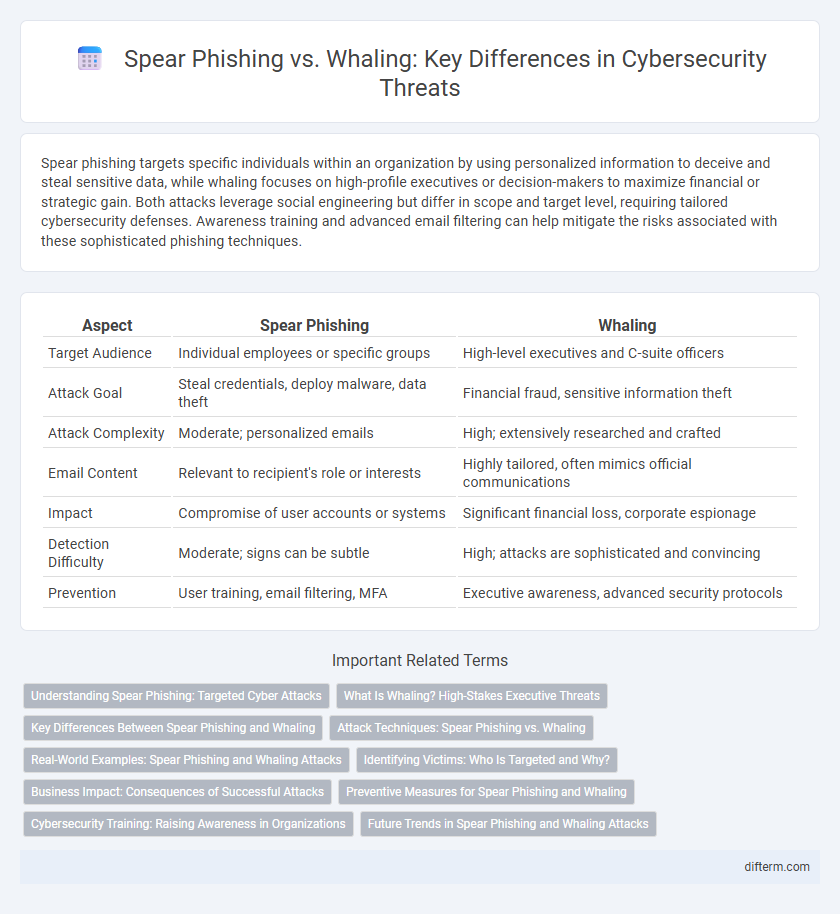Spear phishing targets specific individuals within an organization by using personalized information to deceive and steal sensitive data, while whaling focuses on high-profile executives or decision-makers to maximize financial or strategic gain. Both attacks leverage social engineering but differ in scope and target level, requiring tailored cybersecurity defenses. Awareness training and advanced email filtering can help mitigate the risks associated with these sophisticated phishing techniques.
Table of Comparison
| Aspect | Spear Phishing | Whaling |
|---|---|---|
| Target Audience | Individual employees or specific groups | High-level executives and C-suite officers |
| Attack Goal | Steal credentials, deploy malware, data theft | Financial fraud, sensitive information theft |
| Attack Complexity | Moderate; personalized emails | High; extensively researched and crafted |
| Email Content | Relevant to recipient's role or interests | Highly tailored, often mimics official communications |
| Impact | Compromise of user accounts or systems | Significant financial loss, corporate espionage |
| Detection Difficulty | Moderate; signs can be subtle | High; attacks are sophisticated and convincing |
| Prevention | User training, email filtering, MFA | Executive awareness, advanced security protocols |
Understanding Spear Phishing: Targeted Cyber Attacks
Spear phishing involves highly targeted cyber attacks that use personalized information to deceive specific individuals or organizations, making it more sophisticated than generic phishing. Attackers often research their targets extensively, exploiting trusted relationships and specific vulnerabilities to increase the likelihood of success. Unlike whaling, which targets high-profile executives, spear phishing can focus on employees at various organizational levels to gain unauthorized access or confidential information.
What Is Whaling? High-Stakes Executive Threats
Whaling is a targeted spear phishing attack aimed at high-level executives such as CEOs and CFOs, exploiting their roles to access sensitive corporate information or authorize significant financial transactions. These cyberattacks leverage customized social engineering tactics and often mimic legitimate business communications to bypass security measures. Due to the high stakes involved, whaling poses a severe risk to organizational security and financial integrity.
Key Differences Between Spear Phishing and Whaling
Spear phishing targets specific individuals or employees by using personalized information to appear legitimate, while whaling focuses on high-profile executives or senior management within an organization. Spear phishing emails often aim to steal login credentials or deploy malware, whereas whaling attacks seek larger financial gains or sensitive corporate data through highly tailored, convincing messages. The scale and impact differ significantly, with whaling posing a greater risk due to the high-level access and authority of its targets.
Attack Techniques: Spear Phishing vs. Whaling
Spear phishing targets specific individuals or small groups using personalized information to deceive victims, often involving emails that appear legitimate and relevant to the recipient's role or interests. Whaling attacks focus exclusively on high-profile targets such as executives or key decision-makers, employing sophisticated social engineering tactics that mimic critical business communications like legal subpoenas or urgent financial requests. Both attack techniques leverage psychological manipulation and detailed reconnaissance to exploit trust and gain unauthorized access to sensitive data or systems.
Real-World Examples: Spear Phishing and Whaling Attacks
Spear phishing attacks often target employees with tailored emails resembling legitimate company communications, such as the 2016 Democratic National Committee breach that compromised sensitive political data. Whaling attacks specifically focus on high-profile executives, exemplified by the 2016 Snapchat CFO scam where attackers impersonated the CEO to fraudulently request a $1 million transfer. Both attack types leverage social engineering tactics to exploit trust and access valuable organizational assets.
Identifying Victims: Who Is Targeted and Why?
Spear phishing targets specific individuals within an organization by exploiting personal information to gain unauthorized access, often focusing on employees with lower to mid-level access. Whaling attacks concentrate on high-profile executives or key decision-makers, leveraging their authority and sensitive information to maximize financial or strategic gain. Understanding the victim profile is crucial for developing tailored cybersecurity measures against these sophisticated social engineering threats.
Business Impact: Consequences of Successful Attacks
Successful spear phishing attacks typically lead to unauthorized access to sensitive employee data and financial information, resulting in significant operational disruptions and monetary losses for businesses. Whaling attacks, targeting high-profile executives, can cause severe reputational damage, regulatory penalties, and strategic setbacks due to compromised confidential communications. Both attack types increase the risk of intellectual property theft, customer data breaches, and long-term erosion of stakeholder trust.
Preventive Measures for Spear Phishing and Whaling
Preventive measures for spear phishing and whaling include implementing advanced email filtering systems and multi-factor authentication to detect and block fraudulent activities. Employee training on recognizing personalized phishing attempts and verifying suspicious communications with direct contacts significantly reduces the risk of successful attacks. Regular software updates and cybersecurity awareness programs further strengthen defenses against targeted social engineering threats.
Cybersecurity Training: Raising Awareness in Organizations
Spear phishing targets specific individuals within an organization using personalized information, while whaling focuses on high-profile executives to extract sensitive data. Cybersecurity training programs emphasize raising awareness about these tailored attacks by teaching employees to recognize deceptive emails and verify suspicious requests. Implementing phishing simulations and continuous education significantly enhances an organization's defense against these sophisticated social engineering threats.
Future Trends in Spear Phishing and Whaling Attacks
Emerging AI-driven spear phishing and whaling attacks are expected to become increasingly sophisticated, leveraging deepfake technology and personalized social engineering to evade traditional detection methods. Cybercriminals will likely exploit advancements in natural language processing to create highly convincing and context-aware phishing content targeting high-profile individuals and executives. Enhanced cybersecurity measures incorporating behavioral analytics and machine learning models will be crucial to counteract these evolving threats in the near future.
spear phishing vs whaling Infographic

 difterm.com
difterm.com